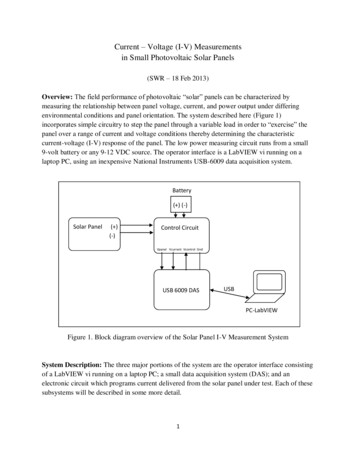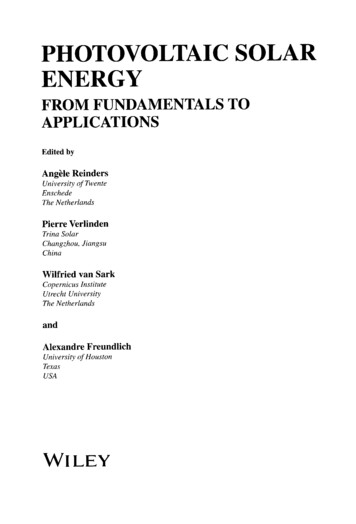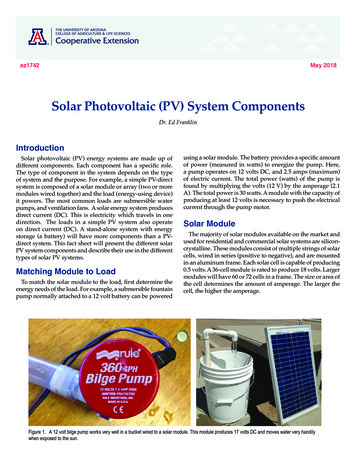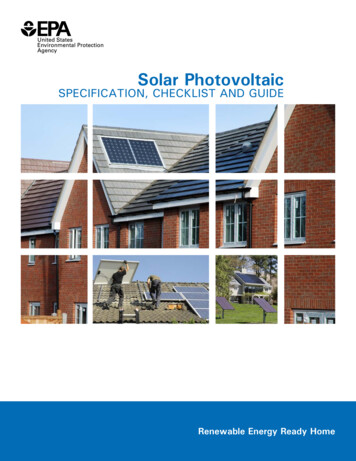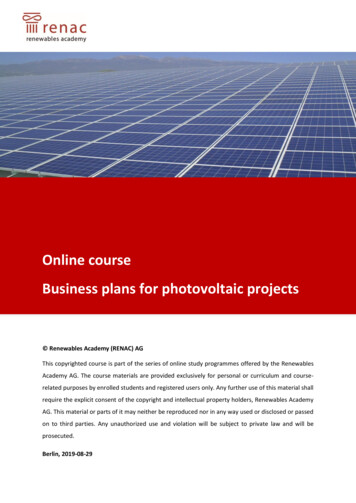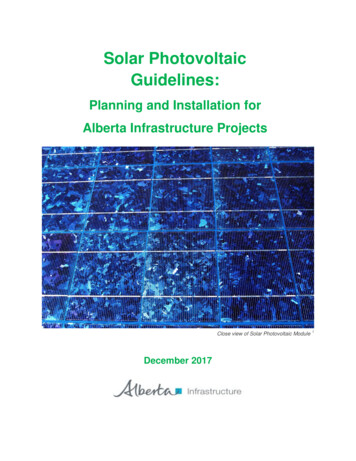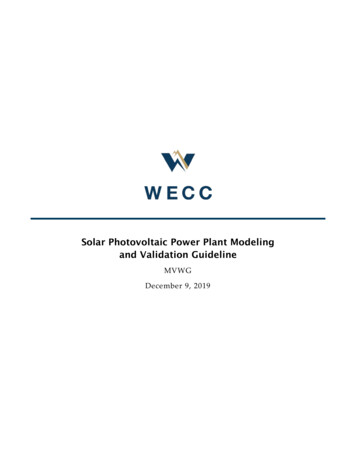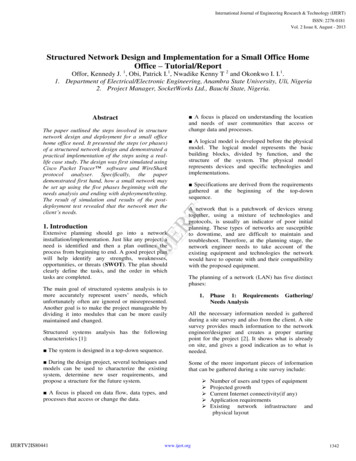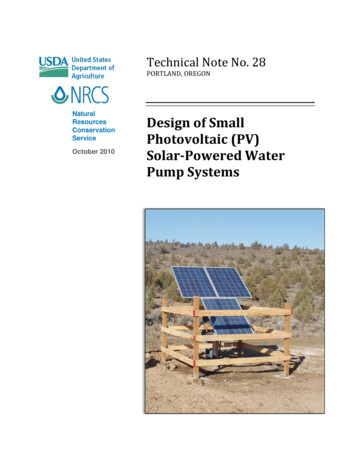
Transcription
Technical Note No. 28PORTLAND, OREGONNaturalResourcesConservationServiceOctober 2010Design of SmallPhotovoltaic (PV)Solar-Powered WaterPump Systems
Design of Small Photovoltaic (PV) Solar-Powered Water Pump SystemsIssued October 2010Cover photo courtesy of Nicholle Kovach, Basin Engineer, USDA NRCS.Trade names mentioned are for specific information and do not constitute aguarantee or warranty of the product by the Department of Agriculture oran endorsement by the Department over other products not mentioned.The U.S. Department of Agriculture (USDA) prohibits discrimination in all itsprograms and activities on the basis of race, color, national origin, age,disability, and where applicable, sex, marital status, familial status, parentalstatus, religion, sexual orientation, genetic information, political beliefs, reprisal, or because all or a part of an individual’s income is derived from anypublic assistance program. (Not all prohibited bases apply to all programs.)Persons with disabilities who require alternative means for communicationof program information (Braille, large print, audiotape, etc.) should contactUSDA’s TARGET Center at (202) 720–2600 (voice and TDD).To file a complaint of discrimination, write to USDA, Director, Office of CivilRights, 1400 Independence Avenue, SW., Washington, DC 20250–9410, orcall (800) 795–3272 (voice) or (202) 720–6382 (TDD). USDA is an equalopportunity provider and employer.Technical Note No. 28, October 2010ii
Design of Small Photovoltaic (PV) Solar-Powered Water Pump SystemsACKNOWLEDGEMENTSThis technical note was written by Teresa D. Morales, Oregon StateDesign Engineer, United States Department of Agriculture (USDA)Natural Resources Conservation Service (NRCS), Portland, Oregon, andJohn Busch, Oregon State Irrigation Engineer, USDA NRCS, Baker City,Oregon.Drawings by Kristi Yasumiishi, Civil Engineering Technician, USDA NRCS,Portland, Oregon.Reviewed by Dave Dishman, Oregon State Engineer, USDA NRCS,Portland, Oregon; Stefanie Aschmann, Leader of Energy TechnologyDevelopment Team, NRCS West National Technology Support Center(WNTSC), Portland, Oregon; Peter Robinson, Water ManagementEngineer, NRCS WNTSC, Portland, Oregon; Clarence Prestwich,Irrigation Engineer, NRCS WNTSC, Portland, Oregon; Kip Yasumiishi,Civil Engineer, NRCS WNTSC, Portland, Oregon; Kelly Albers, BasinEngineer, USDA NRCS, Tangent, Oregon; Ginny Cairo, Basin Engineer,USDA NRCS, Roseburg, Oregon; Bill Cronin, Basin Engineer, USDA NRCS,Medford, Oregon; Kevin Shaw, Basin Engineer, USDA NRCS, Baker City,Oregon.Edited by Erin McDuff, Administrative Assistant, USDA NRCS, Portland,Oregon.Technical Note No. 28, October 2010iii
Design of Small Photovoltaic (PV) Solar-Powered Water Pump SystemsPREFACEThe intent of this technical publication is to provide general guidance onthe design of small solar-powered water pump systems for use withlivestock operations or irrigation systems. This document provides areview of the basic elements of electricity, a description of the differentcomponents of solar-powered water pump systems, important planningconsiderations, and general guidance on designing a solar-poweredwater pump system. This publication also provides design examples fortypical design scenarios and standard drawings for use by the reader.However, this technical note is not intended to be used as a standalonedocument. Instead, users are encouraged to consult the NRCS NationalEngineering Manual (NEH 210) on hydraulics and irrigation engineeringfor additional assistance in the design of water delivery systems.All sources used in the development of this technical note are providedin the References section at the back of the document.Technical Note No. 28, October 2010iv
CONTENTS1.Design of Small Photovoltaic (PV) Solar-Powered Water Pump SystemsINTRODUCTION . 11.01.12.ELECTRICITY BASICS .2THE PHOTOELECTRIC EFFECT .2SOLAR RADIATION, SOLAR IRRADIANCE, AND SOLAR INSOLATION . 32.02.13.SEASONAL AND LATITUDE VARIATION .5CLOUD COVER .5PHOTOVOLTAIC (PV) PANELS . 63.03.13.24.0PV PANEL ELECTRICAL CHARACTERISTICS .6PV PANEL ORIENTATION AND TRACKING .7ENVIRONMENTAL FACTORS .8STRUCTURE AND FOUNDATION CONSIDERATIONS . 84.04.14.24.3STRUCTURAL SUPPORTS FOR PV PANELS.8MOUNTING POSTS .8EMBEDMENT CONSIDERATIONS FOR MOUNTING POSTS.9CORROSION PROTECTION.95.0ELECTRICAL CONTROLLERS . 106.0SOLAR-POWERED PUMPS . 116.06.17.DESIGN PROCESS . 147.07.17.27.37.47.57.67.77.87.97.107.118.PUMP SELECTION AND SYSTEM DESIGN .11SOLAR-POWERED PUMP CHARACTERISTICS .13STEP 1 – WATER REQUIREMENT .14STEP 2 – WATER SOURCE .14STEP 3 – SYSTEM LAYOUT .15STEP 4 – WATER STORAGE .17STEP 5 – SOLAR INSOLATION AND PV PANEL LOCATION.17STEP 6 – DESIGN FLOW RATE FOR THE PUMP .17STEP 7 – TOTAL DYNAMIC HEAD (TDH) FOR THE PUMP .18STEP 8 – PUMP SELECTION AND ASSOCIATED POWER REQUIREMENT .18STEP 9 – PV PANEL SELECTION AND ARRAY LAYOUT .18STEP 10 – PV ARRAY MOUNTING AND FOUNDATION REQUIREMENTS.18STEP 11 – WATER FLOW RATES AND DELIVERY POINT PRESSURE .19STEP 12 – SUMMARY DESCRIPTION OF THE SYSTEM.19ADDITIONAL CONSIDERATIONS . 19Technical Note No. 28, October 2010v
Design of Small Photovoltaic (PV) Solar-Powered Water Pump SystemsAPPENDIXESAPPENDIX A:REFERENCES . 20APPENDIX B:ADDITIONAL RESOURCES . 21APPENDIX C:DESIGN EXAMPLES . 22DESIGN EXAMPLE 1:DESIGN EXAMPLE 2:SOLAR-POWERED WATER PUMP SYSTEM USING SURFACE WATER (A STREAM) AS A WATER SOURCE .22SOLAR-POWERED WATER PUMP SYSTEM USING SUBSURFACE WATER (A WELL) AS A WATER SOURCE .28APPENDIX D:SOLAR INSOLATION VALUES FOR OREGON . 36APPENDIX E:NREL APPROACH TO DETERMINING SOLAR INSOLATION VALUES . 46APPENDIX F:STANDARD DRAWINGS. 50APPENDIX G:FRICTION HEAD LOSS FOR SCHEDULE 40 PVC PLASTIC PIPE . 56APPENDIX H:SAMPLE WELL LOG . 57APPENDIX I:OREGON DEPARTMENT OF FISH AND WILDLIFE FISH SCREENING CRITERIA . 58APPENDIX J:SOLAR PANEL WIRING . 60APPENDIX K:GLOSSARY OF SOLAR-POWERED WATER PUMP TERMS . 61LIST OF FIGURESFIGURE 1 – A TYPICAL SOLAR-POWERED WATER PUMP SYSTEM, WHICH INCLUDES A SOLAR ARRAY, CONTROLLER, PUMP, AND STORAGETANK. (SOURCE: “THE MONTANA AGSOLAR PROJECT – EXPANDING THE AGRICULTURAL USES OF SOLAR ENERGY IN MONTANA.”) 1FIGURE 2 – THE PHOTOELECTRIC EFFECT AND SUBSEQUENT ELECTRON MOTION. (IMAGE INSPIRED BY .3FIGURE 3 – SOLAR IRRADIANCE AND PEAK SUN HOURS. .4FIGURE 4 – EXAMPLE SUMMER AND WINTER SUN ELEVATION AND ANGLE. (SOURCE: “RENEWABLE ENERGY PRIMER-SOLAR.”) .5FIGURE 5 – SOLAR CELL, PV SOLAR PANEL, AND PV PANEL ARRAY. (SOURCE: “GUIDE TO SOLAR POWERED WATER .6FIGURE 6 – SOLAR PANEL TILT ANGLES: WINTER TILT WITH MORE ANGLE FROM HORIZONTAL [LEFT] AND SUMMER TILT WITH LESS.8FIGURE 7 – PV SOLAR ARRAY WITH STORAGE TANK AND STOCK. .11FIGURE 8 – TYPICAL SURFACE INSTALLATION WITH PERTINENT PARAMETERS. .12FIGURE 9 – TYPICAL WELL INSTALLATION WITH PERTINENT PARAMETERS.12FIGURE 10 – EXAMPLE SOLAR-POWERED PUMP PERFORMANCE CURVES FOR A POSITIVE DISPLACEMENT PUMP.13FIGURE 11 – EXAMPLE SOLAR-POWERED PUMP PERFORMANCE CURVES FOR A CENTRIFUGAL PUMP. .13FIGURE 12 – A PLAN OF AN EXAMPLE WATERING SYSTEM WITH A STORAGE TANK AND PV ARRAY. .16FIGURE 13 – ELEMENTS OF A TYPICAL INSTALLATION SUPPLIED BY A SURFACE WATER SOURCE. .16Technical Note No. 28, October 2010vi
LIST OF TABLESDesign of Small Photovoltaic (PV) Solar-Powered Water Pump SystemsTABLE 1 – ELECTRICITY FOR NON-ELECTRICAL .2TABLE 2 – SOLAR RADIATION FOR FLAT-PLATE COLLECTORS FACING SOUTH AT A FIXED TILT OF 43 FOR NORTH BEND, OR .4TABLE 3 – EXAMPLE PV SOLAR PANEL ELECTRICAL .6TABLE 4 – TYPICAL WATER USE REQUIREMENTS .14LIST OF EQUATIONSEQUATION 1.2EQUATION 2.2EQUATION 3.18Technical Note No. 28, October 2010vii
1. INTRODUCTIONDesign of Small Photovoltaic (PV) Solar-Powered Water Pump SystemsPhotovoltaic (PV) panels are often used foragricultural operations, especially in remoteareas or where the use of an alternative energysour
Drawings by Kristi Yasumiishi, Civil Engineering Technician, USDA NRCS, Portland, Oregon. Reviewed by . Dave Dishman, Oregon State Engineer, USDA NRCS, Portland, Oregon; Stefanie Aschmann, Leader of Energy Technology Development Team, NRCS West National Technology Support Center (WNTSC), Portland, Oregon; Peter Robinson, Water Management
